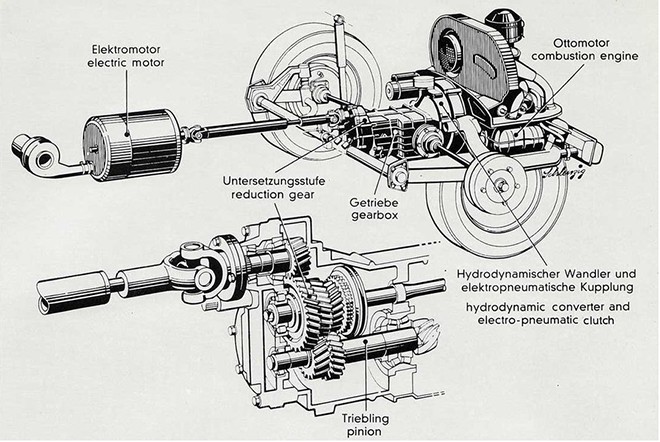There truly is nothing new under the sun, as the saying goes.
Now, a Volkswagen bus from almost 40 years ago has surfaced to prove the point.
While hybrid cars have only emerged as a practical alternative to straight internal-combustion over the past 15 years, this recent success was proceeded by decades of experimentation.
CHECK OUT: Mercedes-Benz Touts Its Hybrid History From Way Back In 1906 (May 2014)
History is full of obscure attempts to improve efficiency by both enterprising inventors and established carmakers.
Perusing a 1979 book titled The Complete Book of Electric Vehicles, Jason Torchinsky over at Jalopnik (via Charged EVs) stumbled upon an experimental Volkswagen Microbus hybrid taxi.

1977 Volkswagen Microbus hybrid, from 'The Complete Book of Electric Vehicles'
Despite its authoritative title. the book does not include the year this prehistoric hybrid was built, but a German Microbus fan site lists it as 1977.
The hybrid was equipped with a rear-mounted, air-cooled flat-four engine just like a standard Microbus, displacing 1.6 liters and producing 50 horsepower.
However, the engine used was apparently a Type I version from a Beetle, not the somewhat different Type IV typically deployed in the Microbus.
The engine was mated to a Bosch electric motor, and array of 11 storage batteries allowed for electric-only running.
Fuel economy was estimated at 20 mpg according to the standards of the time, and that's probably the most impressive statistic about this vehicle.
Its performance was considerably less impressive; it took 30 seconds to reach 60 mph, and topped out at 65 mph.
That may have something to do with the other modifications made by Volkswagen.

1977 Volkswagen Microbus hybrid, from 'The Complete Book of Electric Vehicles'
To prepare the Microbus for taxi duty, VW added an electric sliding side door, and a bulletproof divider (yes, really) between the driver and the passenger compartment.
Volkswagen envisioned the Microbus hybrid as an efficient way to move people around cities, although it's unclear if it ever got the chance to do that.
Neither source contains any details on the hybrid's operational history, and its eventual fate is unknown.
In the end, both the Toyota Prius and Honda Insight hybrids used more energy-dense nickel-metal-hydride battery packs, rather than the VW hybrid's lead-acid batteries.
Still, it's interesting to ponder what might have happened if hybrid powertrains had reached production roughly two decades before the Insight and Prius arrived on the scene.
_______________________________________________












